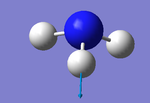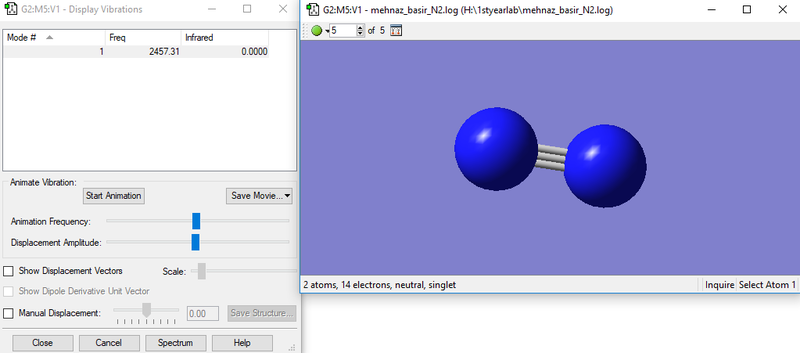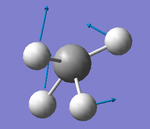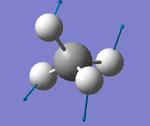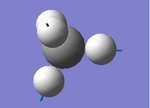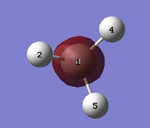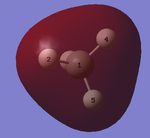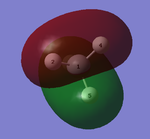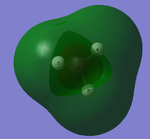Rep:Title=Mod:mb7418introtomolecularmodel
Title
NH3 molecule
| Key information | |
|---|---|
| Calculation method | RB3LYP |
| Basis set | 6-31G(d.p) |
| Final energy, E(RB3LYP) (au) | -56.5577687 |
| RMS gradient (au) | 0.00000485 |
| Point group | C3V |
N-H bond distance = 1.02Å (2 d.p)
H-N-H bond angle = 106° (0 d.p)
Item Value Threshold Converged? Maximum Force 0.000004 0.000450 YES RMS Force 0.000004 0.000300 YES Maximum Displacement 0.000072 0.001800 YES RMS Displacement 0.000035 0.001200 YES
Project molecule
NH3 molecule |
The optimisation file is liked to here
In the NH3 molecule, Nitrogen atom has a charge of -1.125 and all the Hydrogen atoms have a charge of 0.375. I would expect the Nitrogen atom's charge to be more negative in comparison. the reason for this is because Nitrogen is more electronegative in comparison to the Hydrogen atoms. Hence it'll have a higher electron density thus making it more negative.
6 modes are expected from the (3N-6) rule. The modes 2 and 3 are degenerate. 5 and 6 are also degenerate to each other. Modes 1, 2 and 3 are bending vibrations whilst modes 4, 5 and 6 are bond stretch vibrations. The mode which is highly symmetrical is 4. The umbrella mode is 1. 2 bands are expected to be seen in an experimental spectrum of gaseous ammonia due to there being two degenerate pairs. In addition, modes 5 and 6 have an intensity of 0.
N2 molecule
| Key information | |
|---|---|
| Calculation method | RB3LYP |
| Basis Set | 6-31G(d,p) |
| Final energy, E(RB3LYP) (au) | -109.5241287 |
| RMS Gradient Norm (au) | 0.00000365 |
| Point Group | D*H |
N≡N bond distance = 1.11Å (2 d.p)
N2 is a linear molecule.
Item Value Threshold Converged? Maximum Force 0.000006 0.000450 YES RMS Force 0.000006 0.000300 YES Maximum Displacement 0.000002 0.001800 YES RMS Displacement 0.000003 0.001200 YES
Project molecule
N2 molecule |
The optimisation file is liked to here
| Mode | Wavenumber (cm-1) | Symmetry | Intensity (arbitrary) |
|---|---|---|---|
| 1 | 2457 | SGG | 0 |
Both Nitrogen molecules have no charge. The reason for this is because they are the same element, hence they have the same electronegativities. So the molecule is non polar as the charge is distributed evenly along both atoms.
H2 molecule
| Key information | |
|---|---|
| Calculation method | RB3YLB |
| Basis set | 6-31G(d.p) |
| Final energy, E(RB3LYP) (au) | -1.1785394 |
| RMS Gradient Norm (au) | 0.00000017 |
| Point Group | D*H |
H-H bond distance = 0.74Å (2 d.p)
Item Value Threshold Converged? Maximum Force 0.000000 0.000450 YES RMS Force 0.000000 0.000300 YES Maximum Displacement 0.000000 0.001800 YES RMS Displacement 0.000001 0.001200 YES
Project molecule
H2 molecule |
The optimisation file is liked to here
| Mode | Wavenumber (cm-1) | Symmetry | Intensity |
|---|---|---|---|
| 1 | 4466 | SGG | 0 |
Both Hydrogen atoms have a charge distribution of 0. This shows it's a non polar molecular as it has no difference in charge.
Structure and reactivity of H2
Unique identifier = CEFCAS
[[1]]
| Molecule | H-H bond (Å) |
|---|---|
| H2 | 0.74 |
| CEFCAS | 1.48 |
The H-H bond in the H2 molecule is shorter compared to the H-H bond in the metal complex. The reason for this is because the hydrogen atom is bonded to both the transition metal and another hydrogen. The bond density in the H-H bond becomes smaller compared to the bond density in the H-TM (TM = transition metal) bond. This causes the H-H bond to become longer. In addition, the bonds may be different due to computational errors. This can be fixed by using a different method.
Haber-Bosch reaction energy calculation for NH3
E(NH3)= -56.5577687 au
2*E(NH3)= -113.1155374 au
E(N2)= -109.5241287 au
E(H2)= -1.1785394 au
3*E(H2)= -3.5356182 au
ΔE=2*E(NH3)-[E(N2)+3*E(H2)]= -0.0557905 au = -146.5(1 d.p) kJ/mol
The exothermic reaction is favoured. The forward reaction is exothermic. Hence there will be a higher production of ammonia in this reaction because ammonia is more stable.
CH4 molecule
| Key information | |
|---|---|
| Calculation method | RB3LYP |
| Basis set | 6-31G(d.p) |
| Final energy, E(RB3LYP) (au) | -40.5240140 |
| RMS Gradient Norm (au) | 0.00003263 |
| Point Group | TD |
C-H bond distance = 1.07Å (2 d.p)
H-C-H bond angle = 109° (0 d.p)
Item Value Threshold Converged? Maximum Force 0.000063 0.000450 YES RMS Force 0.000034 0.000300 YES Maximum Displacement 0.000179 0.001800 YES RMS Displacement 0.000095 0.001200 YES
Project molecule
CH4 molecule |
The optimisation file is liked to here
The carbon atom has a charge distribution of -0.930 and all the hydrogen atoms have a charge distribution of 0.233. The reason why the carbon atom is more negative is because it has a higher electronegative value compared to hydrogen. hence the electrons in the carbon-hydrogen bond will be more attracted to the carbon. Therefore, the carbon atom has a higher electron density compared to the hydrogens atoms. Thus it is more negative.
9 modes are expected from the (3N-6) rule. The modes 1, 2 and 3 are degenerate which each other. Mode 4 and 5 are degenerate to each other. Modes 7, 8 and 9 are also degenerate to each other. Mode 6 is highly symmetrical. 2 bands are expected to see in an experimental spectrum of gaseous methane.
Haber-Bosch reaction energy calculation for CH4
C + 2H2 → CH4
E(H2)= -1.1785394 au
2*E(H2)= -2.3570788 au
E(C)= -37.77600769 au
E(CH4)= -40.5240140 au
ΔE=E(CH4)-[E(C)+2*E(H2)]= -0.39092751 au = -1026.4 kJ/mol
[[2]]
Independence - O2
| Key information | |
|---|---|
| Calculation method | RB3LYP |
| Basis set | 6-31G(d.p) |
| Final energy, E(RB3LYP) (au) | -150.2574243 |
| RMS Gradient Norm (au) | 0.00007502 |
| Point group | D*H |
O=O bond distance = 1.22Å (2 d.p)
Item Value Threshold Converged? Maximum Force 0.000130 0.000450 YES RMS Force 0.000130 0.000300 YES Maximum Displacement 0.000080 0.001800 YES RMS Displacement 0.000113 0.001200 YES
Project molecule
O2 molecule |
The optimisation file is liked to here
| Mode | Wavenumber (cm-1) | Symmetry | Intensity (arbitrary) | Type of vibration |
|---|---|---|---|---|
| 1 | 1643 | SGG | 0 | Stretch |
Marking
Note: All grades and comments are provisional and subject to change until your grades are officially returned via blackboard. Please do not contact anyone about anything to do with the marking of this lab until you have received your grade from blackboard.
Wiki structure and presentation 0.5/1
Is your wiki page clear and easy to follow, with consistent formatting?
YES
Do you effectively use tables, figures and subheadings to communicate your work?
YES, overall it is good, however you didn't use the built in headings which allow the wiki to auto-generate a table of contents, this is very useful to the reader of a long wiki page with lots of data.
NH3 1/1
Have you completed the calculation and given a link to the file?
YES
Have you included summary and item tables in your wiki?
YES
Have you included a 3d jmol file or an image of the finished structure?
YES
Have you included the bond lengths and angles asked for?
YES
Have you included the “display vibrations” table?
YES
Have you added a table to your wiki listing the wavenumber and intensity of each vibration?
YES
Did you do the optional extra of adding images of the vibrations?
YES
Have you included answers to the questions about vibrations and charges in the lab script?
YES
N2 and H2 0.5/0.5
Have you completed the calculations and included all relevant information? (summary, item table, structural information, jmol image, vibrations and charges)
YES
Crystal structure comparison 0.5/0.5
Have you included a link to a structure from the CCDC that includes a coordinated N2 or H2 molecule?
YES
Have you compared your optimised bond distance to the crystal structure bond distance?
YES
Haber-Bosch reaction energy calculation 1/1
Have you correctly calculated the energies asked for? ΔE=2*E(NH3)-[E(N2)+3*E(H2)]
YES
Have you reported your answers to the correct number of decimal places?
YES
Do your energies have the correct +/- sign?
YES
Have you answered the question, Identify which is more stable the gaseous reactants or the ammonia product?
YES
Your choice of small molecule 4.5/5
Have you completed the calculation and included all relevant information?
YES
Have you added information about MOs and charges on atoms?
YES, very good explanations well done. Note that MO6 is actually the antibonding counterpart to the bonding MO2.
Independence 1/1
If you have finished everything else and have spare time in the lab you could:
Check one of your results against the literature, or
Do an extra calculation on another small molecule, or
Do some deeper analysis on your results so far
You did an extra calculation on O2 well done!






